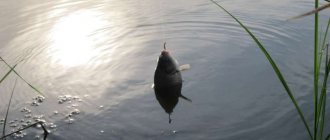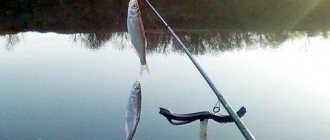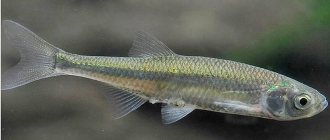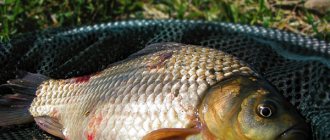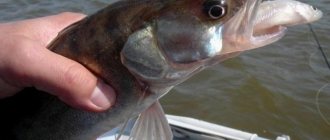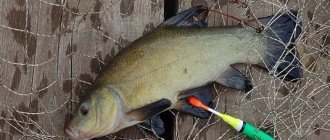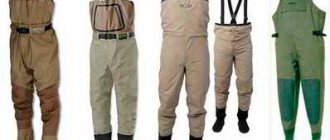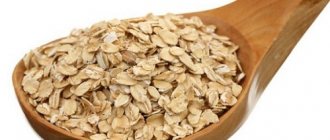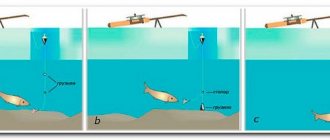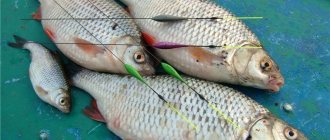Autumn fishing for agile and cunning bleak is a very exciting and gambling activity. Autumn bleak, unlike summer bleak, is larger and, when hooked, gives the fisherman real pleasure, actively resisting when fishing.
The hefty autumn bleak caught by many fishermen is used to prepare delicious sprats; This fish is not bad in dried and dried form.
Place and time of catching bleak in autumn
The autumn feeding season for bleak begins in mid-late August and continues almost until freeze-up. Bleak bite in the fall throughout the day, but most actively: - from the morning until 11-12 noon; - a few hours before sunset. Inclement weather and strong winds, as well as sudden cold snaps, worsen the bite or stop it altogether.
In autumn, schools of bleak most often feed in: - backwaters and creeks of rivers with weak currents or standing water, - near steep banks in areas with a sandy bottom; - in places where a slow flowing stream from a backwater cutting into the bank borders the main flow of the river.
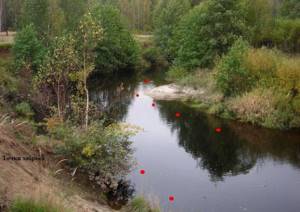
Unlike in summer, the depth of schools of bleak in autumn is significantly below the surface of the water - usually at this time schools actively move, changing horizons and descending as much as possible to the middle layers of water.
Catching bleak in winter
What to do when your fish doesn't bite?
Reservoirs in the city
Also in autumn, bleak prefers to stay further from the coastline, and bites from large specimens should be counted on during long casts.
Which float is best?
The fishing market offers a huge selection of floats of different designs, configurations, and carrying capacity. But we are only interested in two types:
- One is teardrop-shaped, lightweight (1-1.5g load capacity), with a short antenna but a long, thin keel. Such a float, when properly loaded, performs well in the current: the long keel prevents it from quickly turning over when slowing down during retrieval, and the short antenna does not allow the autumn wind to dangle it from side to side.
- The second is cone-shaped, sliding, without a keel, with a long antenna, and a carrying capacity of 6-8 grams. When casting far, it will play the role of a weighting agent. It should be loaded in such a way that the main load is as far away from the hook as possible. For this purpose, the leash is made up to 60 cm long, but it is additionally equipped with a padding, approximately in the middle of the length. This way, foreign objects will not spook the fish.
Such float designs are not dogma, but they are time-tested and have excellent results.
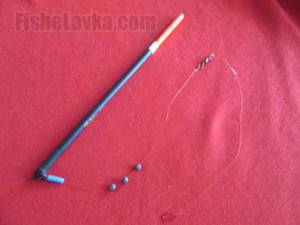
Photo 3. Adhesive installation with a swivel as a backup.
Gear for bleak
The main equipment used for fishing for bleak during the open water season is a float rod. At the same time, the choice of the type of rod and equipment differs somewhat when fishing on a river in a reservoir and in a lake.
Fishing rod for bleak
For fishing, lightweight carbon fiber fly rods with a length of 4 to 6 meters with a thin and sensitive last leg are used. Such a rod will allow you to hold it in your hand throughout the entire fishing without tiring it and making the most effective hooks.
Line for catching bleak
Bleak rarely grows very large, so to catch it, use a thin monofilament line with the following cross-section: - for the main line - 0.16 mm; - for a leash - 0.1 mm.
The color of a thin fishing line does not matter much when fishing for fatliquoring bleak - with such a thickness it is hardly noticeable in the water.
When equipping a fishing rod, the main line is made half a meter shorter than the rod - this allows you to experiment with the length of the leash, making it short (10-12 cm) or long (up to 40 cm), hook and pull the fish.
To prevent twisting, the leash is attached to the main line using a miniature swivel. The equipment is attached to the tip connector, stored and transported wound on a plastic reel.
Hooks for catching bleak
To catch bleak, the hook size is selected based on the bait used: - for bloodworms - No. 18-20; - maggot - No. 16-18; - for semolina chatter - No. 14-16. When using bait, the hooks should be thin and have a blade-type attachment.
Float for catching bleak
Various floats are used for bleak float tackle. Their choice depends on the fishing conditions: - for fishing in calm, windless weather, on reservoirs without a current, use “Needle” type floats, which have an elongated needle-shaped body, a short keel and an antenna painted orange, white or another color. The weight of such floats is from 0.5 to 1.0 grams; - when fishing in windy weather on a wave, as well as for weak currents, floats with a spindle-shaped, drop-shaped small body, a short antenna and a long thin keel are more suitable. The color of the antenna, as in the previous version, should be bright and clearly visible. Their weight should be from 1.0 to 1.5 grams.
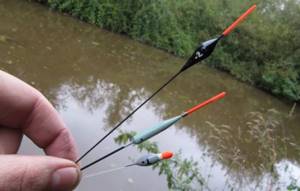
Such floats are loaded with small weights and pellets. Also, when loading, take into account the weight of the swivel used.
☸ Feeding
The fall of a ball of bait onto the water is accompanied by a loud splash, to which the bleak immediately reacts. No, she doesn’t get scared and doesn’t rush in different directions, but rather gathers at this point. To keep it as long as possible, you have to constantly throw in bait.
When feeding, it is very important to adhere to two rules. First, you need to serve portions at equal intervals, without overfeeding or releasing the fish. Secondly, you must try to hit the same place, otherwise it will scatter, which will negatively affect the bite. Remember: an experienced angler feeds with one hand and catches with the other. This is the main principle of successful bleak fishing with a float rod.
Bait for bleak in autumn
For feeding, use store-bought bait for catching roach in cold water. Prepare the bait mixture in such a consistency that when it hits the water it begins to disintegrate, forming a cloudy spot. When casting, bait that is too dense and viscous will sink very quickly and feed the bottom layers without forming an attractive feeding spot.
When fishing with bloodworms, it is recommended to add a small amount of large larvae, previously crushed with your fingers, to the bait - this will increase their attractiveness in the water and increase the speed of their fall.
The device of a simple and lightweight float rod
The most common fishing rod consists of the following elements: rod, fishing line, float, weight, leash with a hook.
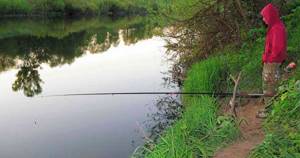
Rod
To catch such fish you will need a strong, light, elastic rod up to 4 meters long. The fishing rod should be such that when casting, as little energy as possible is expended. If the pond does not have a clear coastal line, then you will need a fishing rod up to 6 meters long. A longer rod will be heavier and more uncomfortable. It is best to use durable and lightweight carbon rods, but you should know that it is not recommended to fish with such rods during a thunderstorm. It is also possible to use fiberglass and composite fishing rods.
Equipment
Naturally, one rod is not enough for effective fishing; it must be equipped with the following elements:
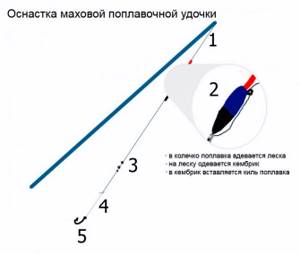
- Leskoy . A fishing line with a diameter of 0.16-0.18 mm is suitable as the main one, and for a leash you can use a fishing line with a diameter of 0.12 mm.
- Float . It should not be a large and very light float, with which you can equip a sensitive fishing rod. The top of the float can be painted in a bright color, followed by opening with varnish.
- Leash . The leash plays a very important role, and more than one. Firstly, it is less noticeable to the fish, since it is thinner, and secondly, during the hook, one leash will be torn off, and the remaining elements will remain intact.
- Loader . To make the tackle sensitive, you can use several small lead pellets as a sinker, attached to a fishing line, at a distance of 2-3mm from one another.
- Crochet . Since the fish is not large, the hooks should be chosen accordingly. These can be hooks No. 16-22, according to the international classification.
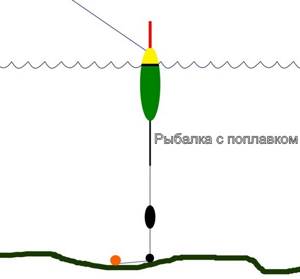
Loading
In order for the tackle to be sensitive, it must be configured correctly. To do this, you need to load the float or, in other words, select a load so that there is only one tip on the surface of the water, then when bitten it will instantly sink. With this setting, you can make timely hooks, which will make it possible to catch fish.
Tactics for catching bleak in autumn
After selecting a place where the bleak is likely to feed, or based on external signs (circles on the water, splashes), it is not fed very generously at first.
Further fishing comes down to finding the distance from the shore and the horizon where the school of bleak is located. To do this, the angler, after several casts and no bites, changes the depth by 10-15 cm. If, after fishing several horizons, the fish bite is weak or completely absent, they change the place where the process of searching for schooling bleak at different depths is repeated.
The found place is periodically fed in small portions - this allows you to keep the fish close to the hook with the nozzle and make its bite more active.
Rod selection
When going to the river, it is better to take a light 4-5-meter fishing rod, because you will have to fish in the coastal waters, choosing an area with a significant deepening of the bottom landscape. If you successfully determine the location, you will have to swing the fishing rod actively, so a longer length will be disadvantageous both in terms of excess weight and in terms of inconvenience.
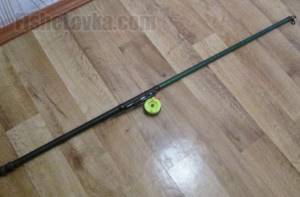
Photo 2. Light three-meter fishing rod.
Stagnant bodies of water present a slightly different picture. Deep places begin far from the shore; you have to rely on long casting using a relatively heavy float. Therefore, you need to choose a fishing rod no more than 3.5 - 4 meters long, equip it with a spinning reel for ease of casting and retrieving equipment.
Search for bleak
Bleak prefers to stay in the upper layers of water, feeding mainly on insects that have fallen into the water.
It can be found in shallow places with moderate currents, under overhanging trees, in thickets of water lilies and reeds. However, schools of these fish do not stand still; they constantly migrate across the reservoir in search of food. The movement of schools does not occur chaotically, but exclusively in the direction of the wind.
They begin to catch bleak in early spring, 2-3 weeks after the ice melts. During this period, it sticks to deep areas, sometimes coming to the shore to feed. You should look for it at the confluence of melt water streams - unique sources of food that carry insect larvae and grass seeds in their waters.
It is best to use a small worm, maggot and bloodworms as bait. Vegetable baits in early spring arouse suspicion among this cautious fish. The best time to catch bleak is the end of May, when the first flight of insects from the bottom begins.
In summer, on the contrary, bleak is best caught on bread, dough and steamed cereals, but insects remain its favorite food. From spring streams, schools move to shallow areas of the reservoir where there are trees and aquatic vegetation that protect small fish from predators. The summer bleak bite is the most confident. However, when weather conditions change, this fish immediately goes deeper and stops feeding.
As the water gets colder, the fish become less active, but continue to stay in the well-warmed shallows. In late autumn, when its state becomes close to torpor, a hungry bleak eats everything that swims by, but it bites best on a combined bait such as a “sandwich” of maggot and pearl barley, as well as on various insects.
In winter, this fish is caught with a winter fishing rod using the same bloodworm or a jig. Winter mooring sites for bleaks are coastal shallows with bottom vegetation.

